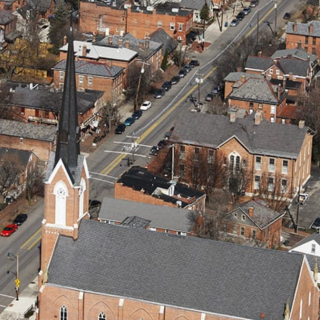Advertisement
The affordable housing crunch in Columbus is growing by the day and you can see one of its causes at the corner of Lane and High just off-campus.
Located there is the shiny new Wilson Place, where (trustafarian) Ohio State students can rent a tiny 2-bedroom with a 24-hour concierge for $2,400-a-month.
No doubt the Scott Schiff-owned property – yes, the ambulance chaser who is also one of the largest property owners around OSU – is putting upward pressure on the cost of off-campus housing.
Negatively affected is a huge number of not-as-fortunate young adults in need of affordable housing.
The invasion of over-priced apartments has caused local market price, which was once affordable, to overheat. And as the region continues to boom both economically and in popularity, greedy landlords can’t resist but to overcharge.
For Central Ohio the average cost of rent has risen from $758 in 2013 to $942 in 2018, according to local real estate research firm Vogt Strategic Insights. The apartment-finder website Rentcafé states 55 percent of Columbus residents rent, compared to 46 percent in 2006.
No surprise is how homelessness is also spiking. In Ohio over the previous five years homelessness has risen 20 percent to an estimated total of 70,000 persons, according to the Coalition on Homelessness and Housing in Ohio.
It begs us to ask, is our community doing enough as thousands annually move to Columbus for an abundance of jobs that barely pay enough to cover rent?
And what about our policy makers and city office holders? True, in May voters approved a $50 million bond issue which will be used to create and initiate a regional affordable housing strategy.
The problem is, no one knows where the money is going or how it will be spent, says Rev. Tim Ahrens of the First Congregational Church and an outspoken voice for interfaith-based BREAD (Building Responsibility Equality And Dignity), arguably the city’s most influential activist group which decided in 2017 that fighting for affordable housing would be its signature initiative.
There are definitions for low-income people in relation to housing and what a low-income family is, says Ahrens, but the $50 million hasn’t been targeted to any specific income number.
“They have not said ‘this is the group it’s going to and this is what we are going to do,’ and that’s disconcerting,” he says. “It could easily go to developers. It could go to anyone. This doesn’t mean they don’t have a plan, but we just haven’t seen it. I don’t think they actually have plan, though.”
BREAD is also urging Franklin County commissioners to raise the county’s conveyance fee, which is paid by those selling property, and currently at $2 per $1,000 of sale for Franklin County. One of those dollars goes to the state while the other stays locally raising $14 million annually with $7 million going to the Affordable Housing Trust and Community Shelter Board.
Franklin County could charge more, up to $4 per $1,000, but the county is one of 12 out of 88 counties that doesn’t charge this maximum amount allowed by state law.
“We don’t know why they don’t want to raise the fee,” says Ahrens. “For four months we’ve been asking. And what we get is they are looking at a comprehensive plan to deal with poverty in Central Ohio. That is what Kevin Boyce (commissioner) has told us but we haven’t seen it. We get nothing from John O’Grady and Marilyn Brown (the other two commissioners).”
Franklin County spokesperson Tyler Lowry says the county spends $17 million each year on the issue and insisted the county is working on recommendations.
“When that plan is complete in the coming weeks, the commissioners will consider the recommendations and make a decision on future spending and whether raising the conveyance fee is warranted, and if so, by how much,” says Lowry.
As for action on the part of local office holders, who seemingly cowed to every high-end developer’s whim over the previous decade, consider how a former Motel 6 and Knights Inn on West Broad are being converted to 100 efficiency apartments for young adults who have aged out of foster care.
The former foster kids will still be charged $650 per month, which includes utilities. Financing this project is the city, along with the Affordable Housing Alliance of Central Ohio and some private investors.
$650 for an efficiency in Franklinton? For us at Freep, still a bit pricey for such luxury.
Ahrens says this project is just a drop in a bucket that needs $1 billion so to fill the need. Over 50,000 area households are paying half of what they earn on keeping a roof over their heads, according to the Affordable Housing Alliance of Central Ohio.
“I’ve called upon the mayor, the council and the commissioners and said we need a champion. One of you has to step up for low-income people in this county. But no one wants to be a champion, I guess. They are all sort of hiding behind something,” says Ahrens.
He adds, “The reason why they don’t want to step up and help the poor probably has something to do with money. What it’s always about.”



